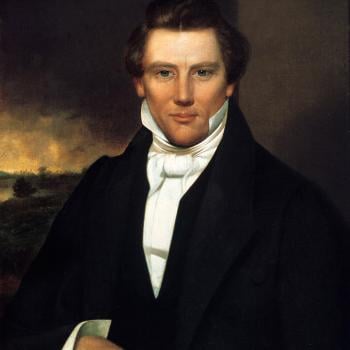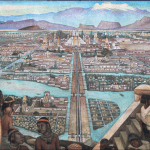 It is my pleasure to present to you an interview with Brenda Colijn, Prof. of Biblical Interpretation and Theology at Ashland Theological Seminary. This interview focuses on her new book, Images of Salvation in the New Testament (IVP, 2010). Not unlike Paul Minear’s book on images of the church in the NT, but with more methodological rigor and more accessible, this book offers penetrating insight on what the NT says about way God has delivered and saved his people.
It is my pleasure to present to you an interview with Brenda Colijn, Prof. of Biblical Interpretation and Theology at Ashland Theological Seminary. This interview focuses on her new book, Images of Salvation in the New Testament (IVP, 2010). Not unlike Paul Minear’s book on images of the church in the NT, but with more methodological rigor and more accessible, this book offers penetrating insight on what the NT says about way God has delivered and saved his people.
1. Brenda, your book is about “images” of salvation in the New Testament. What inspired you to write this book? How do you find “images” or metaphors or word-pictures to be particularly illuminating when studying NT theology?
I wanted to write the book because I’ve been fascinated by the diversity of the New Testament presentations of salvation, while remaining convinced that they all contribute to the same story. I wanted to give full play to the richness of that diversity while asking what holds them together. The study of images is a fruitful way into the theology of the New Testament because it lets us follow where the writers lead us without being constrained by our inherited theological categories, which limit the ways the text can speak. It lets the New Testament speak to us in its own voice. We can’t pretend to read it without any baggage of our own, of course, but at least we are better positioned to hear what the writers (and God through them) want to say to us.
2. You offer a whole host of images: covenant, kingdom, life, new creation, rescue/healing, freedom, justification, election, participation/theosis, holiness/perfection, pilgrimage, etc… Are there images that you think are more central or significant than others?
I could say that some are more central than others because they appear more often, or because I think they are particularly helpful in some way, or because they have been significant in this history of theology. After all, I did choose these images, even though one could make a case for including others. But the New Testament writers didn’t focus on one or two; they gave us a rich array of images. If we really want to understand what salvation is, we need all of them.
3. You spend some time in each chapter showing how the depth and power of each image speaks out to the modern church. When you were researching and writing this book, were their particular images that seemed especially neglected and underappreciated today in the (Western? American?) church?
In general, I think the relational images are less well known than they should be, at least in the American church. I’m thinking of reconciliation and peace, for example. Even well-known images like justification are more relational than we typically think. I was struck by the deep corporate dimension of every image I examined, which challenges the individualism of American culture. Salvation isn’t a solo act. This isn’t a new insight, of course, but when you examine the diversity of New Testament images, it comes through strongly. The Western church has also largely forgotten the participatory language of the New Testament, but we have begun to recover it through interactions with Eastern Orthodoxy. Finally, the idea that the Christian faith requires patient endurance to the end is often neglected.
4. I think you use the term “salvation” in a broader sense than sometimes used in popular lingo or classic textbooks. Can you try and define for us how you use the word in the book?
Salvation, broadly speaking, is God’s activity to restore his creation that has been damaged by sin. The new life that we experience as believers in Jesus is part of that grand plan that God has set in motion. The key to God’s plan is Jesus, who mediates salvation to the world. The Holy Spirit brings God’s offered salvation into the lives of human beings. For human beings, salvation encompasses not just conversion but transformation and fullness of life in Christ–and in Christ’s body–culminating in resurrection, glorification, and eternal life.
5. One of the things you emphasize at the beginning of the book is the cognitive utility of metaphors despite the bad reputation they sometimes get by theologians. Can you briefly summarize how you approach the way that these metaphors are powerful and “true” while still being non-literal and symbolic?
Identifying something as metaphorical is just a way of talking about how that thing functions – it tries to illuminate something unfamiliar (perhaps something abstract or difficult to describe) by comparing it to something familiar (usually something concrete). This act of comparison is fundamental to the learning process. It can also enable us to see already-familiar things in new ways, because it illuminates aspects of the world we haven’t noticed before. Therein lies the power of metaphor to transform us, because it can transform the way we see. Regardless of whether an instance of language is literal or metaphorical, we still have to ask what it’s saying, and then evaluate whether what it’s saying is true or not. When Jesus called Herod a fox, he was speaking truthfully about Herod’s craftiness in metaphorical language. It’s odd that some conservative Christians are wary of metaphor, because we’re quite comfortable with non-literal language like “my Christian walk” and “inviting Jesus into my heart.” We just don’t think of those as metaphors.
6. Thanks for your responses and answers. Would you mind sharing what other projects you would like to work on in the future?
I want to do some research on the historical development of the doctrine of salvation before working toward a more constructive theology of salvation in the future. My next book project will probably be a study of formational hermeneutics – that is, an approach to reading Scripture that integrates study and devotion for the purpose of transformation.















